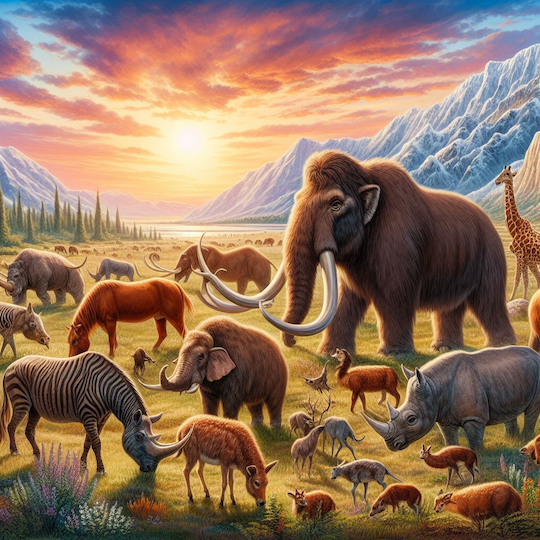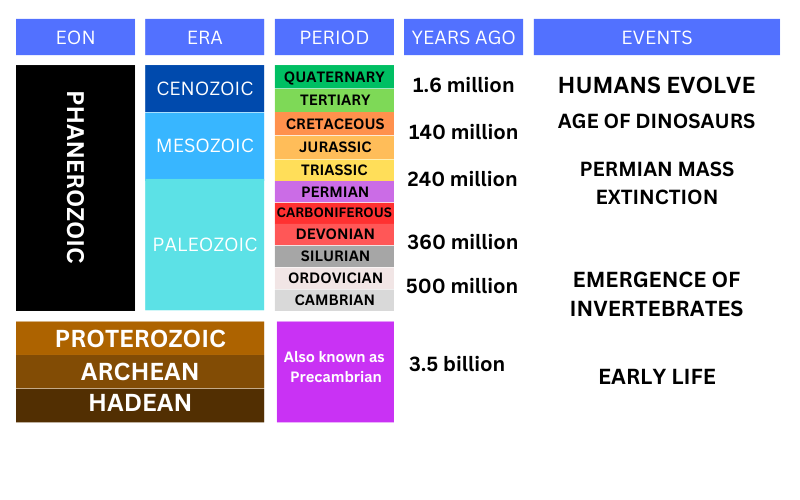Cenozoic Era
 |
| Cenozoic Era Mammals |
Image Credit: BING AI IMAGE GENERATOR |
The Cenozoic Era, often referred to as the "Age of Mammals," marks a critical chapter in Earth's history characterized by the flourishing and diversification of mammalian life. Spanning from approximately 66 million years ago to the present day, the Cenozoic Era encapsulates a vast array of geological and biological transformations.
Epochs of the Cenozoic:
-
Paleogene Period (66 to 23 million years ago):
- The Paleogene witnessed the aftermath of the Cretaceous-Paleogene (K-Pg) extinction event, which led to the demise of non-avian dinosaurs. Mammals seized the opportunity to diversify and occupy ecological niches.
- Early mammals, such as small primates and hoofed mammals, emerged during this period. Iconic mammals like horses and whales also had their evolutionary origins in the Paleogene.
-
Neogene Period (23 to 2.6 million years ago):
- The Neogene period witnessed further diversification and evolution of mammals. Grasslands expanded, providing new habitats for large herbivores and their predators.
- Hominids, the evolutionary ancestors of humans, appeared during the Miocene epoch of the Neogene. The first apes and early hominids marked the initial steps toward the development of the diverse human family tree.
-
Quaternary Period (2.6 million years ago to present):
- The Quaternary is the most recent period of the Cenozoic Era, characterized by a series of glaciations and interglacial periods. The Pleistocene epoch, known for its ice ages, is a prominent feature of the Quaternary.
- Modern humans, Homo sapiens, emerged during the Pleistocene and played a significant role in shaping the ecosystems and landscapes of the planet.
Major Evolutionary Events:
-
Mammalian Diversity:
- The Cenozoic Era saw a remarkable radiation of mammalian life. Mammals diversified into various forms, adapting to diverse environments and ecological niches.
- Notable examples include the evolution of proboscideans (elephants), perissodactyls (horses and rhinoceroses), and artiodactyls (cattle and deer). These groups became dominant herbivores in different ecosystems.
-
Evolution of Whales:
- Whales, descendants of land-dwelling mammals that returned to the sea, underwent significant evolutionary changes during the Cenozoic. Early whale ancestors, such as Pakicetus, transitioned from terrestrial to aquatic life.
-
Primate Evolution:
- Primates, a group of mammals that includes humans, experienced notable evolution during the Cenozoic. The development of grasping hands, forward-facing eyes, and larger brains characterized the adaptation of primates to arboreal life.
-
Impact of Climate Change:
- The Cenozoic Era witnessed fluctuating climates, including periods of global warming and cooling. These climatic shifts influenced the distribution and evolution of plant and animal species, shaping the ecosystems we recognize today.
Human Evolution and Cultural Developments:
-
Hominid Evolution:
- The Cenozoic Era, particularly the Quaternary Period, is integral to the evolution of hominids and the emergence of Homo sapiens. The development of tools, language, and complex social structures marked significant milestones in human evolution.
-
Impact on Landscapes:
- Human activity during the Holocene epoch, a subdivision of the Quaternary, has had a profound impact on landscapes through agriculture, urbanization, and industrialization. This era has seen unprecedented changes to Earth's ecosystems driven by human activities.
